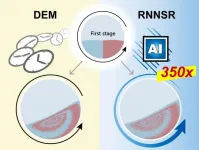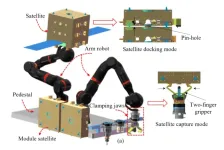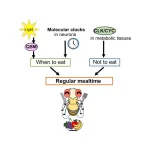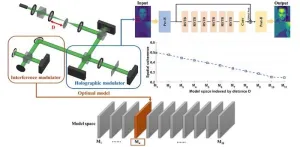(Press-News.org) People have used self-portraits to communicate information about themselves for centuries — and digital cameras make it easier to share a self-portrait than ever before. But even though selfies are now almost ubiquitous, we don’t understand how people use them to communicate. So scientists from the University of Bamberg set out to investigate the semantics of selfies.
“Although the term ‘selfies’ is now celebrating its 21st birthday, and although selfies are known in art history for nearly 200 years in photography and more than 500 years in paintings, we still lack a clear classification of the different types of selfies,” said Tobias Schneider, lead author of the study in Frontiers in Communication and PhD student at the Bamberg Graduate School of Affective and Cognitive Sciences.
Snapshots of selfhood
Previous studies have established that people taking a selfie have three main aims: self-expression, documentation, and performance. Some scientists have used accompanying hashtags and other metadata to decipher the meanings people try to convey with selfies, but this doesn’t consider the picture itself.
To understand what kinds of meaning people ascribe to different selfies, the researchers asked people to describe their first impressions of a sample of selfies. These associations could then be compiled to work out how different types of selfie are understood by viewers.
“Most research addresses direct visual factors, neglecting associative factors that viewers have in mind when browsing through our selfie-oriented world,” said Professor Claus-Christian Carbon, senior author. “Here we used personal reports and associations to describe and categorize selfies in a systematic way.”
Picturing personalities
The scientists created their test dataset from a database of selfies called Selfiecity. They used only self-portraits without any text, taken by a mobile camera, using an individual’s own hands or a selfie stick. The 1,001 selfies remaining were presented at a standard size, on a plain grey background.
The scientists recruited 132 participants online. To avoid tiring participants, they used an algorithm to select 15 random selfies for each participant to review, ensuring that every selfie was evaluated by roughly the same number of people and that each person saw a variety of selfies. The scientists provided five text boxes per selfie for participants to write down their spontaneous reactions.
Schneider and Carbon processed this data to collapse the respondents’ first impressions into 26 categories: for example, ‘mood’ covered comments the respondents made about the selfie-taker’s mood. The scientists then analyzed how frequently these categories appeared in responses, and if they appeared together.
Say it with a selfie
Cluster analysis identified five different clusters of categories, which the authors called ‘semantic profiles’. The largest was named ‘aesthetics’: pictures that showed off style or aesthetic experience. This was very closely followed by ‘imagination’, pictures that led the respondents to imagine where the selfie-taker was or what they were doing, and ‘trait’, images that elicited personality-related terms. Less popular, but still substantial, were the clusters ‘state’, pictures that looked at mood or atmosphere, and ‘theory of mind’, images that caused the respondents to make assumptions about a selfie-taker’s motives or identity.
Each cluster showed a close association of different categories from respondents’ first impressions, suggesting the respondents were picking up on visual language which we use to communicate different aspects of ourselves — whether that’s our terrible mood or our great outfit.
“We were quite impressed how often the category ‘theory of mind’ was expressed, because this is a very sophisticated way of communicating inner feelings and thoughts,” said Schneider. “It shows how effective selfies can be in terms of communication.”
The scientists pointed out that these semantic profiles may not be expressed or understood in the same way worldwide, so more research is needed.
“Research never ends,” said Schneider. “We need more free reports on selfies, more descriptions of how people feel about the depicted persons and scenes, in order to better understand how selfies are used as a compact way of communicating to others.”
“We definitely need larger, more diverse, and cross-cultural samples in the future to understand how different groups and cultures use selfies to express themselves,” added Carbon.
END
Study of 1,000 selfies helps explain how we use them to communicate
Scientists compile thousands of reactions to selfies to understand how we get information from them
2023-10-30
ELSE PRESS RELEASES FROM THIS DATE:
Powder engineering adds AI to the mix
2023-10-30
Imagine a world without powders. It may sound exaggerated, but our daily lives are intricately connected to powders in various ways from foods, pharmaceuticals, cosmetics to batteries, ceramics, etc. In all these industries, powder mixing is an important unit operation where different types of powders are mixed to achieve uniformity. However, it can be difficult to predict what conditions are optimal to achieve the desired uniformity as the process often relies on trial and error as well as engineers’ expertise.
Numerical ...
Risk of admission and death from COVID-19 low overall, but oldest adults remain vulnerable
2023-10-30
About 80% of residents in the Lower Mainland, British Columbia, had been infected with SARS-CoV-2 by July 2023 and were at low risk for severe outcomes, but almost half of the oldest adults remained uninfected and were at highest risk of hospitalization and death due to COVID-19, according to a new study published in CMAJ (Canadian Medical Association Journal) https://www.cmaj.ca/lookup/doi/10.1503/cmaj.230721.
The findings underscore the need to continue prioritizing older adults for COVID-19 vaccination.
"First-ever SARS-CoV-2 infections among older adults may still contribute substantial COVID-19 burden, reinforcing ...
High engagement, high return: The secret to student success
2023-10-29
High engagement, high return. That’s the advice from education experts at the University of South Australia for teachers looking to improve student outcomes.
In a new study conducted in partnership with Flinders University and Melbourne Graduate School of Education, researchers found that less than a third of teachers are engaging students in complex learning, limiting student opportunities for building critical thinking and problem solving.
Filming and assessing* the content of classrooms ...
Robot space maintenance based on human arm dynamics
2023-10-28
On-orbit assembly has become a crucial aspect of space operations, where the manipulator frequently and directly interacts with objects in a complex assembly process. The traditional manipulator control has limitations in adapting to diverse assembly tasks and is vulnerable to vibration, leading to assembly failure. To address this issue, Researchers at Beijing Institute of Technology propose a human-like variable admittance control method based on the variable damping characteristics of the human arm. This method can effectively increase the safety, robustness, ...
Increasing risk of invasive species colonization on marine debris
2023-10-28
A groundbreaking scientific study conducted along the Southeast coast of India has unearthed a pressing environmental concern -the increasing risk of invasive species colonization on marine debris. The research, published recently in Marine Pollution Bulletin, delves into the critical interplay between plastic pollution and the introduction of non-indigenous organisms into Indian waters.
In recent years, the surge in anthropogenic litter in the ocean has provided an extensive array of substrates for marine ...
How do animals know it’s lunchtime?
2023-10-28
Tokyo, Japan – Researchers from Tokyo Metropolitan University have used fruit flies to study how daily eating patterns are regulated. They found that the quasimodo (qsm) gene helped sync feeding to light/dark cycles, but not in constant darkness: instead, the genes clock (clk) and cycle (cyc) keep eating/fasting cycles, while other “clocks” in nerve cells help sync it to days. Deciphering the molecular mechanism behind eating cycles helps us understand animal behavior, including our own.
Many members of the animal kingdom eat at roughly the same times each day. This is born out of the need to adapt to aspects of the environment, including ...
Interdisciplinary research team works to mitigate climate change effects in Texas Gulf Coast communities
2023-10-27
Experts in the Texas A&M University Department of Geography are teaming up with civil and chemical engineers and water resource, disaster recovery and public health researchers across the campus in a collaborative effort to better safeguard Texas Gulf Coast communities against climate-related emergencies, fueled by a three-year, $1.5 million grant from the National Academies Gulf Research Program (GRP).
The project, titled "Climate-LEAD: Climate Effects on Localized Environmental Health Disparities in Overburdened Texas Communities along Gulf Coast," is ...
An updated look at prostate cancer disparities
2023-10-27
Cedars-Sinai Cancer investigators have found that Black men respond as well as white men to systemic therapies for advanced prostate cancer when access to quality healthcare is equal, regardless of socioeconomic status. Their study, published today in the peer-reviewed Journal of Clinical Oncology, counters previous research suggesting that Black men receiving these therapies—which include hormone therapy, chemotherapy and immunotherapy—fare worse than white men do.
“We believe this is the most comprehensive look at this issue to date, and our findings suggest that, under the right conditions, Black men with metastatic ...
New battery technology could lead to safer, high-energy electric vehicles
2023-10-27
University of Maryland researchers studying how lithium batteries fail have developed a new technology that could enable next-generation electric vehicles (EVs) and other devices that are less prone to battery fires while increasing energy storage.
The innovative method, presented in a paper published Wednesday in the journal Nature, suppresses the growth of lithium dendrites—damaging branch-like structures that develop inside so-called all-solid-state lithium batteries, preventing firms from broadly commercializing the promising technology. But this new design for a battery “interlayer,” led by Department of Chemical and Biomolecular Engineering ...
Clear holographic imaging in turbulent environments
2023-10-27
Holographic imaging has always been challenged by unpredictable distortions in dynamic environments. Traditional deep learning methods often struggle to adapt to diverse scenes due to their reliance on specific data conditions.
To tackle this problem, researchers at Zhejiang University delved into the intersection of optics and deep learning, uncovering the key role of physical priors in ensuring the alignment of data and pre-trained models. They explored the impact of spatial coherence and turbulence on holographic ...
LAST 30 PRESS RELEASES:
Scientists trace microplastics in fertilizer from fields to the beach
The Lancet Obstetrics, Gynecology, & Women’s Health: Taking paracetamol during pregnancy does not increase risk of autism, ADHD or intellectual disabilities, confirms new gold-standard evidence review
Taking paracetamol during pregnancy does not increase risk of autism, ADHD or intellectual disabilities
Harm reduction vending machines in New York State expand access to overdose treatment and drug test strips, UB studies confirm
University of Phoenix releases white paper on Credit for Prior Learning as a catalyst for internal mobility and retention
Canada losing track of salmon health as climate and industrial threats mount
Molecular sieve-confined Pt-FeOx catalysts achieve highly efficient reversible hydrogen cycle of methylcyclohexane-toluene
Investment in farm productivity tools key to reducing greenhouse gas
New review highlights electrochemical pathways to recover uranium from wastewater and seawater
Hidden pollutants in shale gas development raise environmental concerns, new review finds
Discarded cigarette butts transformed into high performance energy storage materials
Researchers highlight role of alternative RNA splicing in schizophrenia
NTU Singapore scientists find new way to disarm antibiotic-resistant bacteria and restore healing in chronic wounds
Research suggests nationwide racial bias in media reporting on gun violence
Revealing the cell’s nanocourier at work
Health impacts of nursing home staffing
Public views about opioid overdose and people with opioid use disorder
Age-related changes in sperm DNA may play a role in autism risk
Ambitious model fails to explain near-death experiences, experts say
Multifaceted effects of inward foreign direct investment on new venture creation
Exploring mutations that spontaneously switch on a key brain cell receptor
Two-step genome editing enables the creation of full-length humanized mouse models
Pusan National University researchers develop light-activated tissue adhesive patch for rapid, watertight neurosurgical sealing
Study finds so-called super agers tend to have at least two key genetic advantages
Brain stimulation device cleared for ADHD in the US is overall safe but ineffective
Scientists discover natural ‘brake’ that could stop harmful inflammation
Tougher solid electrolyte advances long-sought lithium metal batteries
Experts provide policy roadmap to reduce dementia risk
New 3D imaging system could address limitations of MRI, CT and ultrasound
First-in-human drug trial lowers high blood fats
[Press-News.org] Study of 1,000 selfies helps explain how we use them to communicateScientists compile thousands of reactions to selfies to understand how we get information from them





